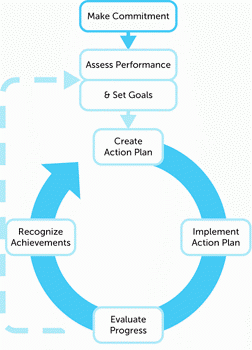Local Topics - Energy Efficiency in Government Operations and Facilities
On this page:
- Building Energy Efficiency for Local Governments
- Increasing the Efficiency of Buildings
- Tools and Resources
Building Energy Efficiency for Local Governments
The average building wastes about a third of the energy it uses. By investing in energy efficiency local governments can achieve substantial energy cost savings throughout their facilities, demonstrate energy and environmental leadership, and raise public awareness of the benefits of energy efficiency.
Increasing the Efficiency of Buildings

Guidelines for Energy Management
EPA offers a proven strategy for superior energy management with tools and resources to help each step of the way. Based on the successful practices of ENERGY STAR partners, these guidelines for energy management illustrated by the graphic below/above can help local governments improve energy and financial performance while distinguishing themselves as an environmental leader.
Approaches to Improving Efficiency in Government Operations and Facilities
Benchmark Building Performance: Local governments can increase building energy efficiency by 10, 20, and 30 percent through effective energy management practices that involve assessing energy performance, setting energy-savings goals, and regularly evaluating progress. Municipalities can use EPA’s no-cost ENERGY STAR Portfolio Manager tool to:
- Identify under-performing buildings to target for energy efficiency improvements
- Establish baselines to set goals and measure progress for energy efficiency improvement projects over time
- Monitor energy efficiency improvements compared to a baseline and track reductions in GHGs
- Document reductions in energy use, GHG emissions, water use, and costs for an individual building or an entire portfolio
Consider Voluntary Programs and Regulatory Policies: Local governments across the country are taking bold steps to protect the environment and lower energy costs by adopting energy efficiency policies that leverage EPA’s ENERGY STAR tools to reduce energy use in buildings, through both required policy measures and voluntary campaigns.
Implement Energy Efficiency Purchasing: Products that have earned the ENERGY STAR label help local governments save energy and money without sacrificing performance. By using less energy, these products also help reduce GHG emissions–caused by the burning of fossil fuels at power plants–that contribute to global warming. ENERGY STAR procurement resources are available to help local governments implement energy efficient purchasing policies with savings calculators, product specifications, sample procurement contract language, and case studies.
Visit ENERGY STAR Buildings & Plants to see the full list of ENERGY STAR resources for commercial buildings.
Benchmarking and Building Performances Standards Policy Toolkit
EPA's Benchmarking and Building Performance Standards Policy Toolkit aims to inform and support state and local government decision makers who are exploring adopting policies focused on reducing energy use and greenhouse gas emissions from existing commercial and multifamily buildings in their communities. The toolkit covers key considerations for policy design, opportunities for cross-jurisdictional coordination, and strategies for using EPA’s ENERGY STAR® Portfolio Manager® tool.
Building Upgrade Manual
The ENERGY STAR Building Upgrade Manual is a strategic guide that can help local governments implement profitable energy saving building upgrades. Governments can maximize energy savings by sequentially following the five building upgrade stages: retro-commissioning, lighting, supplemental load reduction, air distribution systems, and heating and cooling upgrades.
ENERGY STAR for State and Local Governments
ENERGY STAR for State and Local Governments provides local governments a proven energy management strategy and no-cost tools to save energy and money and demonstrate environmental leadership. The program provides information on how to access model government efficiency policies and programs that leverage ENERGY STAR tools like Portfolio Manager and Target Finder.
ENERGY STAR for Wastewater Plants and Drinking Water Systems
Managers of drinking water systems and wastewater treatment plants can now track energy use, energy costs, and associated carbon emissions by using Portfolio Manager, EPA's online benchmarking tool.
ENERGY STAR Qualified Products
Products in more than 60 categories are eligible for the ENERGY STAR. ENERGY STAR qualified products use less energy, save money, and help protect the environment. Local governments can implement energy efficiency purchasing policies to save energy and reduce GHGs.
Local Government Climate and Energy Strategy Series
The Local Government Climate and Energy Strategy Series provide a comprehensive, straightforward overview of local government greenhouse gas (GHG) emission reduction strategies. Staff can use these guides to plan, implement, and evaluate climate and energy projects. Each guide provides an overview of project benefits, policy mechanisms, investments, key stakeholders, and other implementation considerations. Examples and case studies are incorporated throughout the guides. Topics covered in the guides include energy efficiency, transportation, urban planning and design, solid waste and materials management, and renewable energy.
Online Training
ENERGY STAR offers free online training to help local governments improve the energy performance of their operations. Training is available through a variety of formats including live web conferences, animated presentations, pre-recorded trainings, and self-guided presentations.
Portfolio Manager
Portfolio Manager is an online tool you can use to measure and track energy and water consumption, as well as greenhouse gas emissions. Use it to benchmark the performance of one building or a whole portfolio of buildings, all in a secure online environment.
Target Finder
Local governments can use this Web-based tool to assess the energy performance of building designs and existing buildings. Target Finder allows you to see what annual energy usage you need to achieve to meet a target, and to evaluate estimated energy use.
